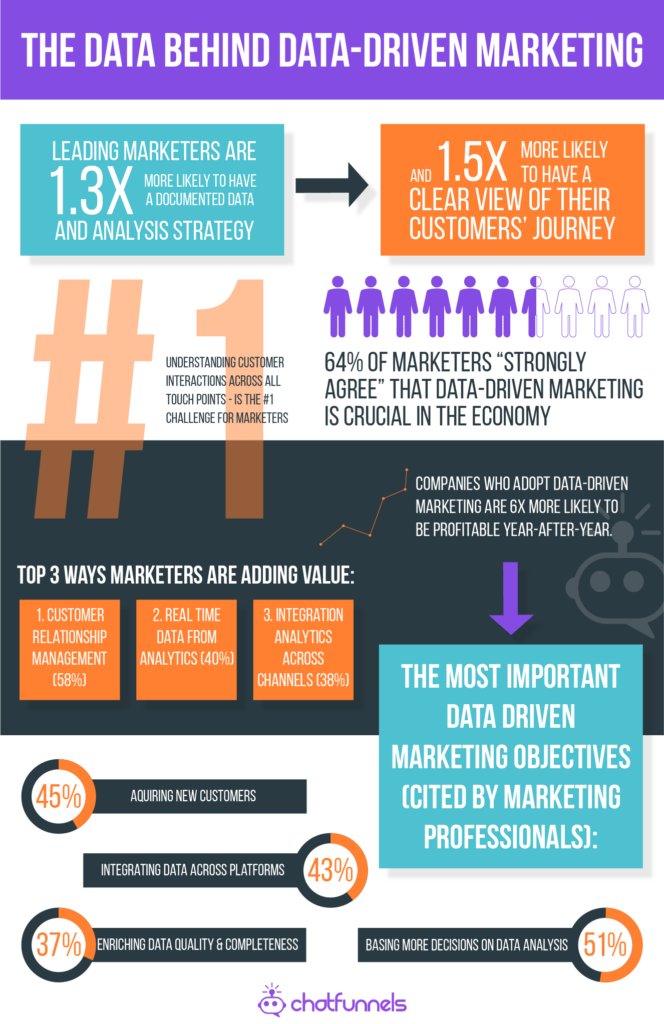Unlock the secrets to maximizing marketing success with data-driven strategies. Learn how analytics can revolutionize your marketing efforts today!

Image courtesy of via DALL-E 3
Table of Contents
Introduction to Data-Driven Marketing
In today’s digital age, marketing has evolved significantly with the advent of data-driven marketing. This cutting-edge approach leverages the power of analytics to drive strategic decisions and enhance marketing efforts. By utilizing data to gain insights into consumer behavior and preferences, businesses can tailor their marketing strategies for maximum impact.
What is Data-Driven Marketing?
Data-driven marketing is a method of making decisions about marketing strategies and tactics based on insights and trends derived from the analysis of data. Essentially, it involves using data to understand consumer behavior, preferences, and tendencies to create more targeted and effective marketing campaigns.
Why is it Important?
Companies today rely on data-driven marketing for several reasons. By harnessing analytics, businesses can gain a deeper understanding of their target audience, which enables them to create personalized and relevant marketing messages. This, in turn, leads to higher engagement, increased conversions, and improved return on investment (ROI).
The Basics of Data Analytics
Data analytics is like detective work for businesses. It involves collecting information from different sources and using that data to solve problems and make smart decisions. Just like a detective gathers clues to solve a mystery, data analysts gather data to understand trends and patterns in customer behaviors.
Types of Data in Marketing
When it comes to marketing, there are various types of data that are used to understand customers better and improve strategies. Customer data includes information like age, location, and purchasing habits. Sales data tracks how many products are sold and which ones are popular. By analyzing this data, companies can tailor their marketing efforts to reach the right audience with the right message.
Collecting Data
In data-driven marketing, collecting data is a crucial step in understanding your audience and making informed decisions. This process involves gathering information from various sources to gain insights into customer behavior and preferences. Let’s explore how marketers collect data to improve their strategies.

Image courtesy of getsignals.ai via Google Images
Sources of Data
Data can come from a variety of sources, both online and offline. Websites, social media platforms, and surveys are common places where marketers gather valuable information about their target audience. By analyzing data from these sources, businesses can better understand their customers’ needs and tailor their marketing efforts accordingly.
Tools for Collecting Data
To streamline the data collection process, marketers often rely on specialized tools and software. Platforms like Google Analytics provide in-depth insights into website traffic, user demographics, and engagement metrics. These tools help businesses track their marketing efforts and identify areas for improvement, ultimately leading to more effective strategies.
Analyzing Data
In data-driven marketing, once the data has been collected from various sources, the next step is to analyze it to extract valuable insights that can inform marketing decisions. Analyzing data involves looking for patterns, trends, and relationships within the information gathered.
Methods of Analysis
One common method of analyzing data is by observing trends over time. By tracking how certain metrics change over a period, marketers can identify patterns that could influence their marketing strategies. For example, they can see if there is a peak in website traffic during specific times of the year or if certain promotions lead to a spike in sales.
Another method is to look for correlations between different sets of data. By examining how changes in one variable affect another, marketers can make informed decisions. For instance, they can analyze how changes in online ads impact website traffic or if there’s a relationship between social media engagement and customer purchases.
Useful Tools for Analysis
There are various tools available to help marketers analyze data effectively. One common tool is Microsoft Excel, which allows users to organize and manipulate data in spreadsheets. With features like charts and pivot tables, Excel makes it easier to visualize data relationships and draw conclusions.
Additionally, specialized software like Tableau or Google Data Studio can help marketers create interactive visualizations of data, making it easier to spot trends and patterns. These tools offer more advanced analytics capabilities, allowing for deeper insights into the collected data.
How to Use Data Insights
Utilizing data insights is crucial in improving marketing strategies and reaching target audiences effectively. By understanding the information gathered from data analysis, marketers can make informed decisions to enhance their campaigns and engage with customers more efficiently.

Image courtesy of growthnatives.com via Google Images
Creating Customer Profiles
One way to leverage data insights is by creating detailed customer profiles. These profiles are like personas that represent your typical customers based on their demographics, behavior, and preferences. By analyzing data such as purchase history, website interactions, and social media engagement, marketers can segment their audience and tailor their messaging to specific groups. Understanding the needs and preferences of different customer segments allows marketers to personalize their marketing efforts and provide relevant content that resonates with their target audience.
Personalizing Marketing Campaigns
Data insights also play a crucial role in personalizing marketing campaigns. By examining customer data, marketers can identify patterns and trends that help them understand individual preferences and behaviors. For example, analyzing past purchase behavior can help determine which products or services a customer is interested in and tailor promotional offers accordingly. Additionally, by utilizing data on customer interactions with emails, websites, and ads, marketers can create personalized messages that speak directly to the needs and interests of each customer. Personalized marketing campaigns not only increase engagement but also drive conversions as customers are more likely to respond to content that is relevant to them.
Benefits of Data-Driven Marketing
In the world of marketing, using data to make decisions can provide businesses with a competitive edge. Let’s explore some of the advantages of incorporating data-driven strategies into marketing efforts.
Improved Decision Making
When businesses analyze data, they can make more informed decisions about their marketing strategies. By looking at key metrics like customer behavior and campaign performance, companies can fine-tune their approaches for better results. This way, marketing decisions are not based on guesswork but on solid data-backed insights.
Better Customer Insight
Understanding your customers is essential for any successful marketing campaign. Data-driven marketing allows businesses to gain deep insights into customer preferences, behaviors, and needs. By analyzing data, companies can tailor their messages and offerings to meet the specific demands of their target audience, leading to stronger customer relationships and higher engagement.
Increased Efficiency
Implementing data-driven strategies can streamline marketing processes and boost efficiency. By relying on data for decision-making, businesses can allocate resources more effectively, target the right audience with the right message, and eliminate wasteful spending on ineffective campaigns. This results in cost savings and improved ROI for marketing initiatives.
Challenges and Considerations
Data-driven marketing relies heavily on collecting and analyzing customer data to tailor marketing strategies. However, it is essential to prioritize the protection of this data. Data privacy ensures that sensitive information shared by customers remains confidential and secure. Companies must adhere to strict privacy regulations to build trust with their customers and avoid any potential data breaches.

Image courtesy of www.binarysemantics.com via Google Images
Data Quality Issues
Another challenge in data-driven marketing is ensuring the accuracy and reliability of the data being used. Inaccurate or outdated data can lead to misguided marketing decisions, resulting in wasted resources and missed opportunities. It is crucial for marketers to regularly clean and update their data to maintain its quality and integrity.
Real-Life Examples
Big companies like Google and Amazon are masters at using data to drive their marketing strategies. For example, Google analyzes search trends and user behavior to deliver targeted ads to consumers. By understanding what users are searching for, Google can show relevant ads that are more likely to convert into sales. Similarly, Amazon uses customer data to personalize product recommendations, sending tailored suggestions to users based on their browsing and purchasing history. This personalized approach makes customers feel understood and valued, leading to increased sales and customer loyalty.
Small Businesses and Data
Even small businesses can benefit from harnessing the power of data-driven marketing. For instance, a local bakery might use data from their online orders to track customer preferences and buying habits. By analyzing this data, the bakery can create targeted email campaigns offering discounts on popular items or promoting new products to specific customer segments. This targeted approach helps the bakery increase sales and build stronger relationships with its customers, all thanks to the insights gained from data analysis.
Conclusion
In conclusion, data-driven marketing is a powerful strategy that utilizes analytics to make informed decisions. By leveraging data, companies can better understand their customers, improve marketing efforts, and ultimately drive business success. Let’s recap some of the key points we’ve covered in this blog post about data-driven marketing.

Image courtesy of www.advancedmarketingtechniques.com via Google Images
Key Takeaways:
Throughout this article, we learned that data-driven marketing involves using information and insights from various sources to create targeted and effective marketing campaigns. Companies collect data from websites, surveys, and other sources using tools like Google Analytics. This data is then analyzed using methods like trend analysis to find valuable information that can improve marketing strategies.
By applying data insights, marketers can create detailed customer profiles and personalize marketing campaigns to engage with their target audience effectively. Some of the benefits of data-driven marketing include improved decision-making, better understanding of customer needs, and increased efficiency in marketing efforts. However, challenges such as data privacy and accuracy must also be considered when implementing data-driven strategies.
Real-life examples from big companies like Google and Amazon, as well as small businesses, demonstrate the success of data-driven marketing in achieving business goals. By utilizing data effectively, companies can gain a competitive advantage and drive growth in today’s digital landscape.
Overall, data-driven marketing is a valuable tool that can help businesses thrive in a data-driven world. By leveraging analytics and insights, companies can make smarter decisions, better understand their customers, and achieve marketing success.
Want to turn these SEO insights into real results? Seorocket is an all-in-one AI SEO solution that uses the power of AI to analyze your competition and craft high-ranking content.
Seorocket offers a suite of powerful tools, including a Keyword Researcher to find the most profitable keywords, an AI Writer to generate unique and Google-friendly content, and an Automatic Publisher to schedule and publish your content directly to your website. Plus, you’ll get real-time performance tracking so you can see exactly what’s working and make adjustments as needed.
Stop just reading about SEO – take action with Seorocket and skyrocket your search rankings today. Sign up for a free trial and see the difference Seorocket can make for your website!
Frequently Asked Questions (FAQs)
What is data-driven marketing?
Data-driven marketing is a strategy where companies use data and analytics to make informed decisions about their marketing campaigns. Instead of guessing what customers might like, businesses use data to understand customer behavior and preferences better.
Why should I use data in marketing?
Using data in marketing can help you create more effective campaigns that are tailored to your target audience. By analyzing data, you can understand what works and what doesn’t, allowing you to make smarter decisions that lead to better results.
Is it difficult to analyze data?
Analyzing data can seem daunting, but with the right tools and methods, it becomes much easier. Tools like Excel and specialized software can help you make sense of the data and identify valuable insights. By using these tools, you can analyze data more efficiently and effectively.







